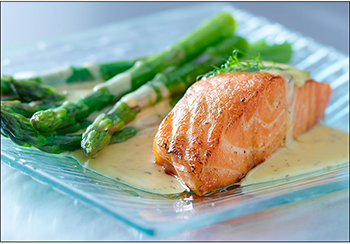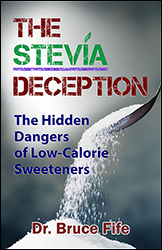E-Mail Edition Volume 13 Number 5
Published Fall, 2016
Published by Piccadilly Books, Ltd., www.piccadillybooks.com.
Bruce Fife, N.D., Publisher, www.coconutresearchcenter.org
If you would like
to subscribe to
the Healthy Ways Newsletter
-
Foods Fight Dementia
-
Artificial Sweeteners Make You Fat!
-
Coconut Oil Skin Treatment for Your Dog
-
Coconut Oil is Saving the Sea Turtles
Foods Fight Dementia
Dementia is a major concern among the elderly. Alzheimer’s is by far the most common cause of dementia. Approximately 5.4 million Americans and 30 million people worldwide have Alzheimer’s disease. The number of people affected is steadily growing. Alzheimer’s is not a disease that just affects the brain, it is a terminal illness. The brain controls the action of all the other organs, when it fails,
Ratatouille, from Dr. Fife's Keto Cookery by Bruce Fife
so do all of the other organs. Recent estimates
suggest that Alzheimer’s has become the third leading cause of death in
the United States, just behind heart disease and cancer.1
Current treatments for
Alzheimer’s have been a dismal failure. A new approach is desperately
needed. One promising approach is through diet therapy, consisting of
mostly foods and supplements. Researchers at UCLA have developed a novel
non-drug based program to reverse memory loss. The program is called
metabolic enhancement for neurodegeneration (MEND). A pilot study
involving 10 participants displayed significant improvement in their
memories beginning within three to six months after the program’s start.2
Of the six patients who had to discontinue working or were struggling
with their jobs at the time they joined the study, all were able to
return to work or continue working with improved performance.
Improvements the patients
have experienced have been sustained and as of this writing, have been
maintained for 2 ½ years since the initial treatment. The subjects
included patients with memory loss associated with Alzheimer’s disease,
amnestic mild cognitive impairment, or subjective cognitive impairment.
The only patient that didn’t show improvement during the study was one
with late stage Alzheimer’s.
The MEND program involves
optimizing nutrient intake with a good diet and key dietary vitamin and
mineral supplementation, limiting carbohydrate consumption, stimulating
ketone production, balancing hormones, taking protective antioxidant and
anti-inflammatory supplements, getting regular exercise, reducing
stress,
getting adequate sleep, chelating toxic metals if necessary, and
consuming a dietary source of MCTs such as coconut oil.
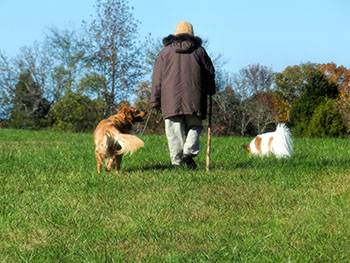
Getting sunshine and healthy exercise walking the dogs.
Photo: themorguefile.com
by Dr. Bruce Fife
Available from Piccadilly Books, Ltd.
A natural, diet-based
approach offers the potential for stopping the disease and even
reversing it, giving the patient many additional productive and quality
years to their life. The new study comes jointly from the UCLA Mary S.
Easton Center for Alzheimer’s Disease Research and the Buck Institute of
Research on Aging. The study author, Dale Bredesen, MD said, “It is
noteworthy that the major side effect of this therapeutic system is
improved health and an optimal
body mass index, a stark contrast to the side effect of many drugs.”
Can you imagine that? The side
effects include better overall health instead of
Asparagus and salmon, from Dr. Fife's Keto Cookery.
Roasted vegetables from Dr. Fife's Keto Cookery.
She sought help with her
memory problems and was told there was nothing that she could do about
it other than take the standard Alzheimer’s drugs, which would have
little effect. She eventually was led to the MEND program. She
eliminated all sugar, gluten, and processed foods from her diet. She
increased her consumption of vegetables, fruits, and non-farmed fish. In
order to reduce stress she began taking yoga classes and to meditate for
20 minutes twice a day. She increased the amount of sleep she got each
night from 4-5 hours to 7-8 hours. She
added vitamin and mineral supplements and MCTs to her diet. She began an
exercise program working out a minimum of 30 minutes a day, 4 to 6 days
a week.

Tai Chi class in the UK. Photo: themorguefile.com
Nine out of the 10 patients
who followed the program had similar success, demonstrating that memory
loss can be reversed and improvement sustained with a dietary and
lifestyle approach. The only subject in the study that failed to respond
was one who had advanced Alzheimer’s disease, indicating that the
earlier a person begins the program the better the results.
The results of this pilot
study were so promising that additional, longer-term studies with larger
numbers of patients are planned. You do not need to wait for the results
of these studies. A safe and effective treatment for Alzheimer’s very
similar to the MEND program is already available in my book
Stop Alzheimer’s Now. If you
or any of your family members are experiencing memory problems you can
take action now before it gets worse or develops into full-blown
dementia. A few simple changes, such as adding coconut oil into your
daily diet,
can make a
difference.
References
1. James, BD, et al. Contribution of Alzheimer disease to mortality in
the United States. Neurology 2014;82:1045-1050.
2. Bredesen, DE. Reversal of cognitive decline: A novel therapeutic program. Aging 2014;6:707-717.
Artificial Sweeteners Make You Fat!
Do you eat foods and
beverages sweetened with sugar substitutes to avoid sugar and help
control calorie intake to manage your weight? Do you drink diet soda in
place of regular soda? Honestly, have these measures ever helped you
lose any weight? If you are like most people, the answer is “No.”

by Dr. Bruce Fife
Oddly enough, replacing
sugar with artificial sweeteners does not help with weight loss. It in
fact, promotes greater weight gain!
When artificial sweeteners
such as aspartame, saccharin, and sucralose were introduced, they were
accompanied with great fanfare and promises that they would reduce
calorie intake and promote weight loss. Theoretically, it seems logical
they could help with weight loss. If you replace the sugar in your diet
with zero-calorie sweeteners, you end up consuming fewer calories, and
therefore, you should lose weight. In theory it makes sense. In reality
it doesn’t work.
When artificial sweeteners
were introduced they were hailed as a partial solution to our growing
obesity problem. Since their introduction the obesity problem has turned
into a full-blown epidemic. Ironically, the solution to the obesity
problem has turned out to be one of the major causes of it!
While foods sweetened with
artificial sweeteners may contain fewer calories than the sugar
sweetened versions, they cause an increase in hunger that leads to
excessive calorie consumption and weight gain.
A number of studies in both
animals and humans have shown that artificial sweeteners tend to promote
more weight gain than sugar does. The reason for this has been a
mystery. A new study, however, offers insights as to why these
sweeteners promote hunger and weight gain.
“There is a lot of
discussion about how these sweeteners actually affect human health,”
says Dr. Greg Neely, an associate professor of genomic at the University
of Sydney in Australia and senior author of the new study. “Our data
show that chronic consumption of [artificially sweetened foods] triggers
a conserved neuronal fasting response and increases the motivation to
eat.”1
The researchers began their
work on fruit flies, giving them either a diet of food sweetened with
sugar or sucralose, the sweetener found in Splenda, for 5 days. (Neely
noted that sucralose was used as the artificial sweetener in part
because fruit flies don’t seem to like saccharin, the sweetener used in
Sweet’N Low.).
The researchers observed
that the flies that had been fed the sucralose diet ate about 30 percent
more calories than the ones that had been eating sugar. The researchers
wanted to know what was going on in the flies’ brains to drive them to
eat more.
Using molecular genetic
approaches to study the activity of brain cells, the scientists found
that the sucralose activated a “fasting response” in the flies’ brains.
In other words, because the flies were consuming fewer calories when
they were fed the sucralose, their brains did not recognize that they
were eating enough calories. And so, to compensate for this perceived
lack of calories in the food, the fasting response pathway in the brain
triggered the flies to eat more.
The researchers found a
neurotransmitter in the brain called neuropeptide F played a role in the
fasting response in the fruit flies. Mice and humans have an analogous
neurotransmitter, called neuropeptide Y.
The researchers conducted
the same experiment using mice with a similar result; those mice that
were fed sucralose-sweetened jellies ate more food than those that were
not given the sucralose. However, when the researchers used genetically
modified mice that did not have neuropeptide Y, sucralose had little
effect on the animals’ appetite. In other words, neuropeptide Y played a
role in how artificial sweeteners affected the animals’ appetites.
These new findings suggest
that in both fruit flies and mice, sucralose promotes increased food
intake. Since humans also have neuropeptide Y, that may explain why
artificial sweeteners tend to promote weight gain in us too. Dr. Neely
also noted that the flies consuming the artificial sweeteners also
exhibited other symptoms, including hyperactivity, insomnia, and glucose
intolerance. Glucose intolerance or insulin resistance is the landmark
feature characteristic of type 2 diabetes.
This isn’t just a
characteristic of sucralose, all artificial sweeteners seem to trigger
the “fasting response” in our brains.2 Consuming foods and
beverages sweetened with artificial sweeteners would not only promote
increased appetite but also cravings, severely challenging the success
of any diet. It appears that if weight loss or weight management is your
goal, it is best to stay away from the artificial sweeteners.
References
1. Wang, QP, et al. Sucralose promotes food
intake through NPY and a neuronal fasting response. Cell Metab
2016;24:75-90.
2. Yang, Q. Gain weight by “going diet?”
Artificial sweeteners and the neurobiology of sugar cravings. Yale J
Biol Med 2010;83:101-108.
Coconut Oil Skin Treatment for Your Dog
Dr. Karen Becker, DVM gives
her dog Rosco a coconut oil treatment weekly to soften his skin and ward
of infection. Rosco is a 15-year-old Boston Terrier. Like most elderly
dogs his skin tends to be flaky and itchy, causing him to scratch and
bite excessively, which can lead to bleeding and infections. An
application of coconut oil on his skin and coat softens his
skin and helps build a natural protective layer to
keep it healthy.

Dr. Karen Becker with her dog Rosco.
by Dr. Bruce Fife
Available from Piccadilly Books, Ltd.
After giving Rosco a bath
and drying his coat, coconut oil is applied liberally over the dog’s
skin and coat, including his paws and nails. Areas that tend to be
excessively flaky or itchy are given special attention to make sure the
oil is worked into the skin. The oil is allowed to soak into the skin
and hair for about 5 minutes. Most dogs love the taste of coconut oil
and will begin licking it off, that’s ok.
You don’t want your dog
running around your house with oil all over its coat, so you will want
to wash off the excess oil with a light application of shampoo and a
final rinse. You don’t need a lot of shampoo or want to remove all the
oil, just the oil on the surface of the dog’s coat. See the video below.

Coconut Oil is Saving the Sea Turtles
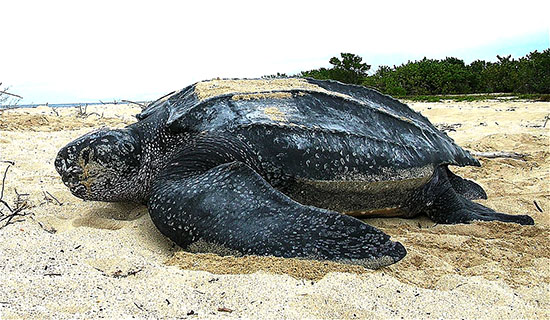
Leatherback sea turtle. Photo by US Fish and Wildlife Service.
The leatherback sea turtle
is the largest living turtle and the heaviest reptile next to the
crocodile. Mature sea turtles are typically between 4 to 6 feet in
length and weigh 650 to 1,100 pounds. The turtles have a characteristic
leather-like shell and a teardrop-shaped body with a large pair of front
flippers to power them through the water.
Adult leatherback sea
turtles don’t have teeth, but rather delicate, scissor-like jaws. Their
jaws would be damaged eating hard foods so they subsist almost entirely
on jellyfish; they are one of the few animals that feed on jellyfish.
The sea turtles’ thick skin, including the skin in their mouths and
throat, are impervious to the jellyfish’s stings. Consequently, sea
turtles are invaluable in controlling jellyfish populations, including
the deadly man-of-war.

Decaying plastic bag resembles a jellyfigh.
Photo by Seegraswiese.
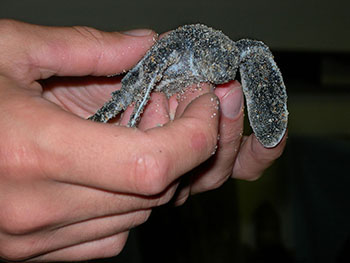
Baby sea turtle. Photo by Dtobias.
Some local communities are
now helping to save the leatherback by making coconut oil. …Come again?
How does making coconut oil help to save sea turtles? It all comes down
to economics. Sea turtles and their eggs are harvested and poached by
local villagers as a means of making a living. The production and sale
of coconut oil creates an alternative source of income for the villagers
living along the sea turtles nesting beaches.
The island Barra de Pacuare
on the eastern coast of Costa Rica is an example. The island is not a
tourist destination and locals have few options of earning income.
Poachers have been hunting the eggs for a lifetime and have no other
marketable skills. It is difficult to stop them from poaching as they
are mostly illiterate and lack any employable skills. However, they are
finding the community production of coconut oil to be a workable
alternative that provides year round income so that they no longer need
to poach sea turtle eggs.
The Casa de Coco (house of
coconut) in Costa Rica is a volunteer organization established to teach
villagers how to set up, produce, and market coconut oil from the
thousands of coconuts that grow wild in the region. Their efforts are
turning long time poachers into successful coconut oil producers. Rather
than stripping the world of an endangered species, they are now
producing a renewable source of food and medicine that benefits
everyone, including the sea turtles. Hooray for the coconut!
Do you have friends who would like this newsletter? If so, please feel free to share this newsletter with them.
If this newsletter was forwarded to you by a friend and you would like to subscribe,
Copyright © 2016, Bruce Fife. All rights reserved.


